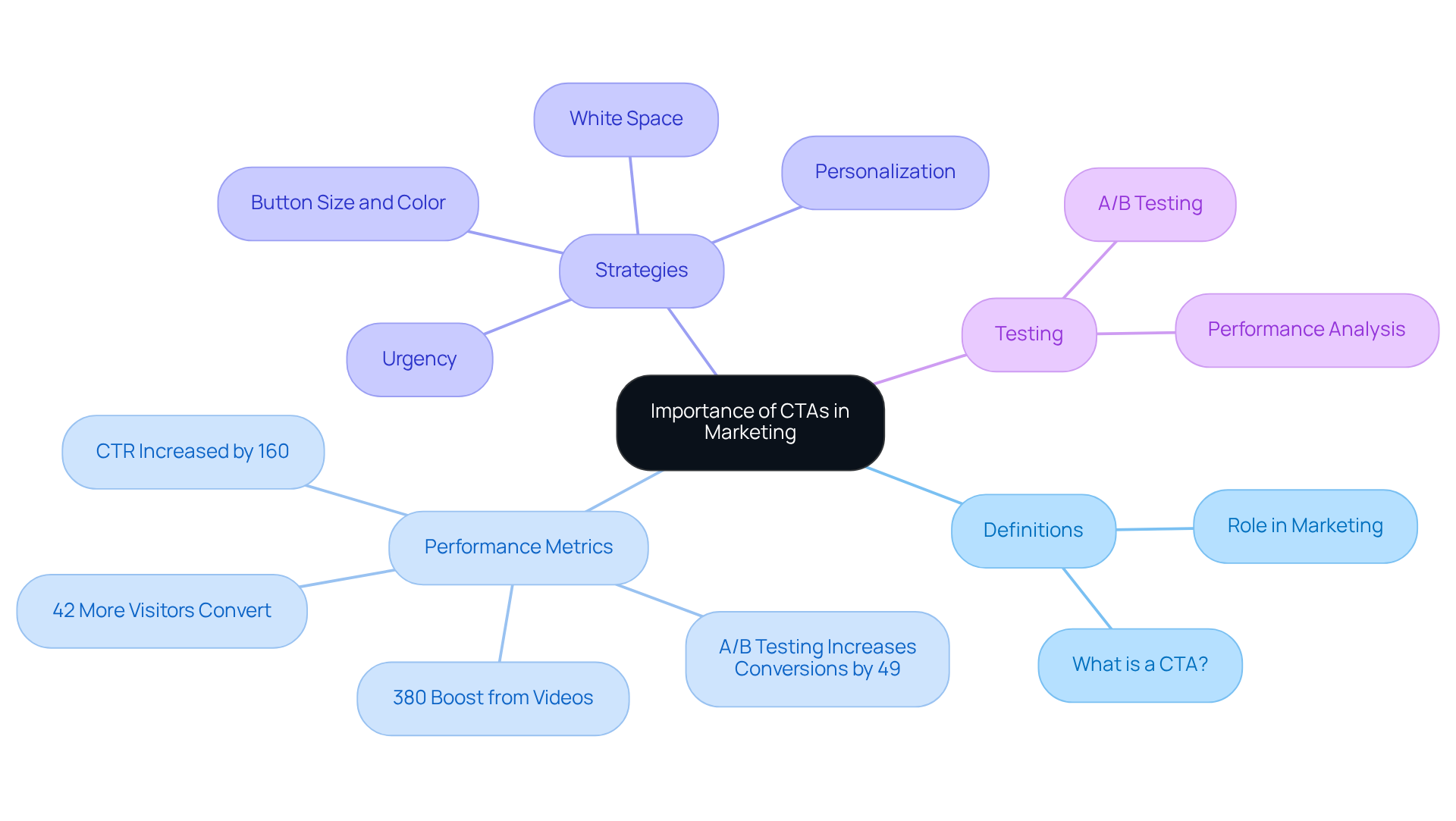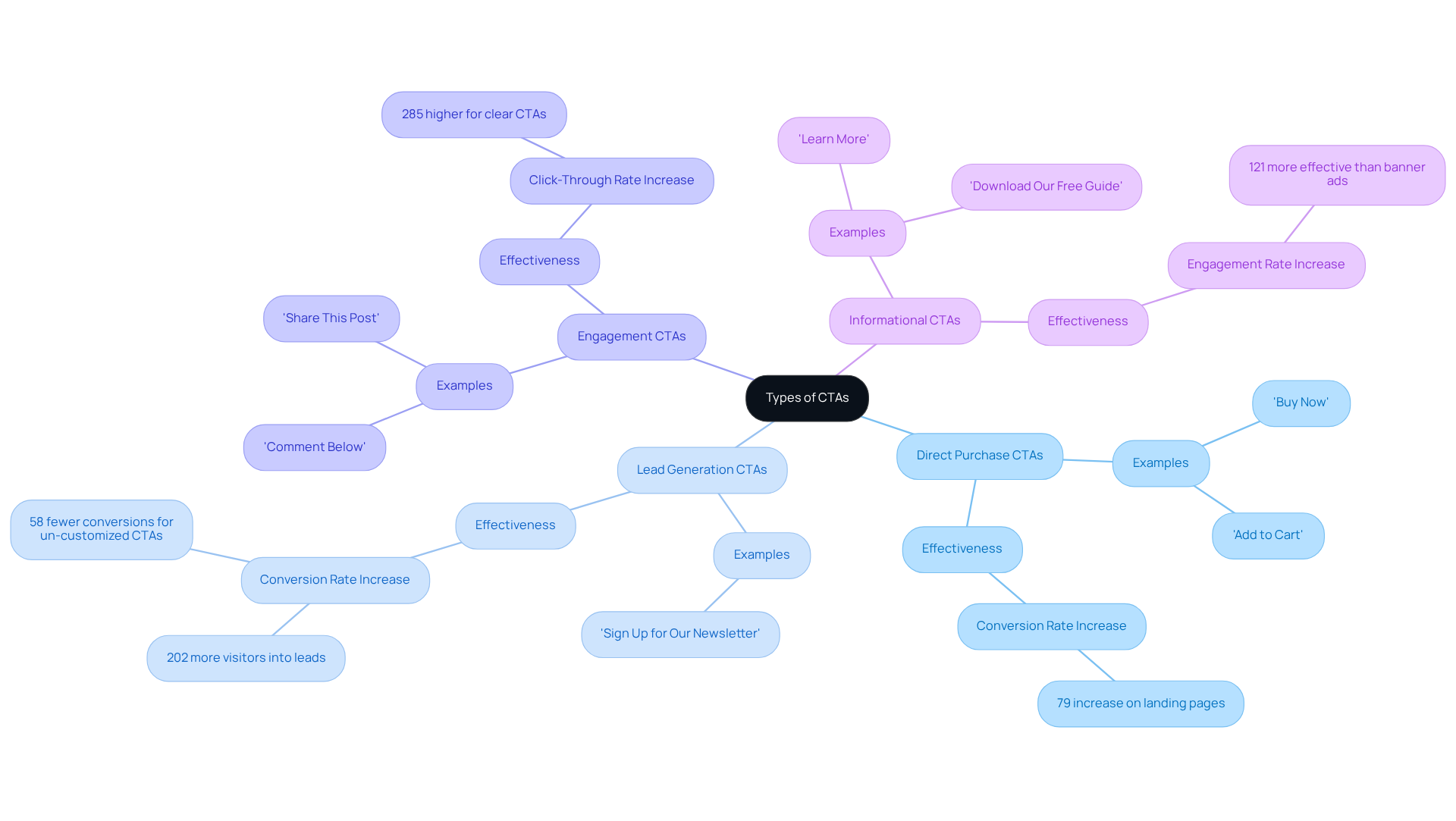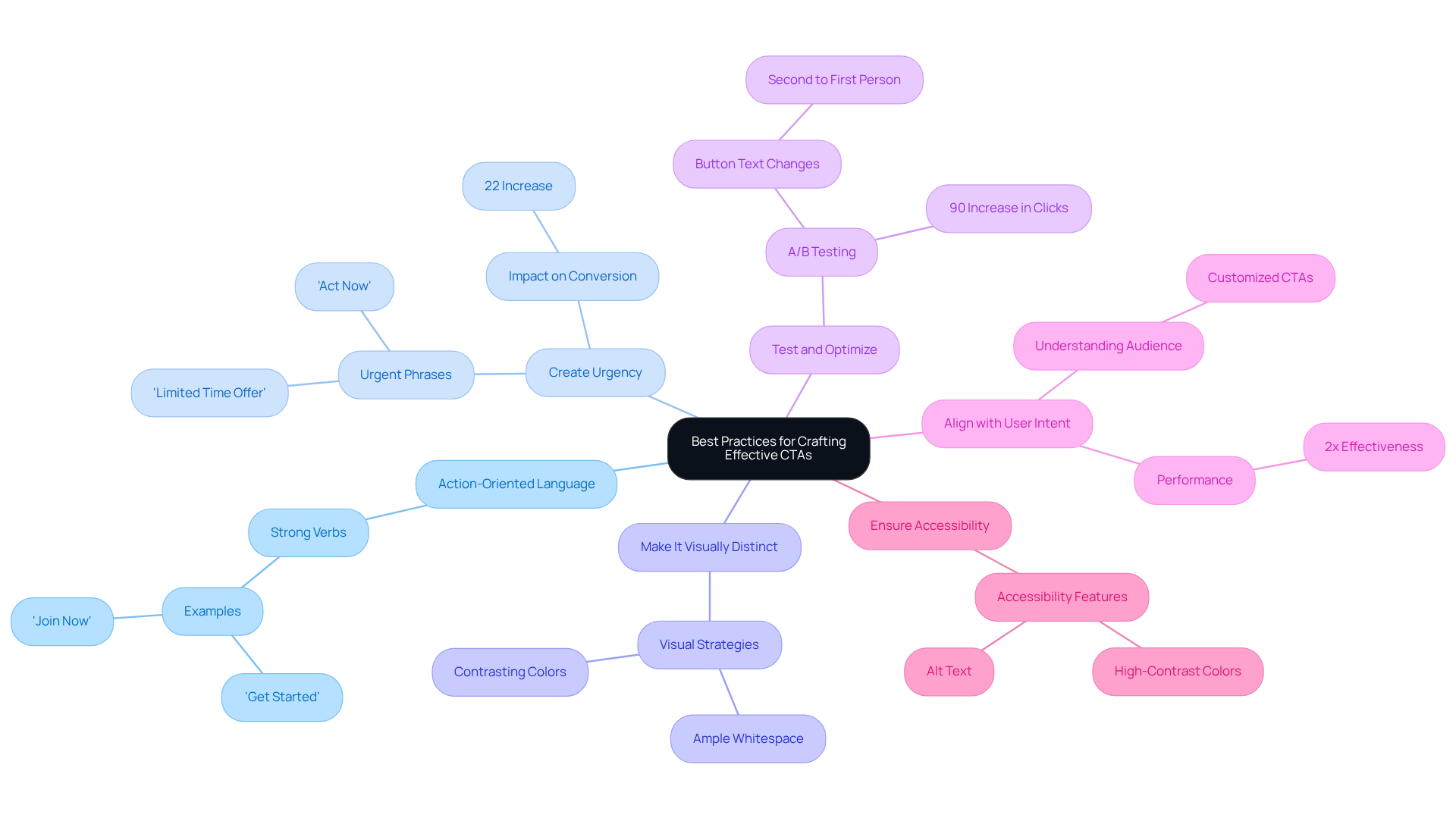
Overview
A call to action (CTA) stands as a pivotal marketing element, meticulously crafted to incite specific actions from the audience—such as making a purchase or subscribing to a newsletter. In the realm of direct-to-consumer (DTC) marketing, CTAs are instrumental in steering potential customers along their buying journey. Effective CTAs not only enhance engagement but also significantly boost conversion rates.
Compelling statistics underscore their impact; for instance, strategically positioned CTAs can yield a remarkable 40% increase in sales. Furthermore, the clarity and urgency embedded within these prompts are paramount in driving user actions, solidifying the CTA's role as a cornerstone of successful marketing strategies.
Introduction
In the competitive landscape of direct-to-consumer marketing, the effectiveness of a Call to Action (CTA) can determine the distinction between a casual browser and a committed buyer. These succinct prompts, whether manifested as buttons or links, are meticulously crafted to guide potential customers through their journey, rendering them indispensable for driving engagement and conversions.
However, with a plethora of options available, how can brands ensure their CTAs not only capture attention but also compel action? A thorough exploration of CTAs unveils not only their definition and significance but also the strategies that can amplify their impact within a crowded digital marketplace.
Define Call to Action (CTA)
What is a call to action? A Call to Action (CTA) serves as a critical marketing element, meticulously crafted to prompt specific actions from the audience, such as clicking a button, signing up for a newsletter, or making a purchase. Typically presented as buttons or links with like 'Buy Now,' 'Subscribe,' or 'Learn More,' these CTAs function as navigational aids that guide individuals through their customer journey. Their effectiveness is underscored by compelling statistics indicating that CTA buttons garner 28% more clicks than those embedded within general text, emphasizing their importance in driving engagement.
In the realm of direct-to-consumer (DTC) marketing, knowing what is a call to action is indispensable in converting potential customers into buyers. They serve as pivotal transitions within the sales funnel, directing users on their next steps—whether that entails visiting a blog, subscribing to an email list, or finalizing a purchase. A highlighted case study revealed that strategically positioned calls to action led to a remarkable 40% increase in sales, further illustrating their efficacy in enhancing engagement rates.
Successful implementations of CTAs in e-commerce further affirm their significance. For instance, Dropbox's explainer video, which concluded with the compelling CTA 'Try Dropbox for free,' played a crucial role in raising $48 million, showcasing the potential of a well-crafted CTA to drive substantial conversions. Similarly, Headspace's video CTA, 'Get to know your mind, Download Headspace,' aligns seamlessly with the brand's emphasis on mental wellness, thereby enhancing viewer engagement.
Expert opinions consistently highlight that clarity is paramount for effective communication regarding what is a call to action. As noted by Unbounce, "Clarity is one of the key elements of a successful CTA." A clearly defined CTA not only heightens the likelihood of users taking action but also enriches the overall customer experience. By incorporating both primary and secondary calls to action, brands can effectively address diverse shopper intents, ultimately resulting in higher conversion rates. Furthermore, considering that 73% of individuals skim through content and devote only 52 seconds per post, effective calls to action are essential for swiftly capturing attention. In conclusion, calls to action are vital instruments in digital marketing, particularly for DTC brands striving to enhance customer interactions and stimulate growth.

Contextualize the Importance of CTAs in Marketing
In marketing, what is a call to action (CTA) strategy, and why is it indispensable as the vital link between consumer interest and decisive action? In an increasingly saturated digital landscape, knowing what is a call to action is essential to effectively capture attention and elicit immediate responses from potential customers. E-commerce platforms frequently employ what is a call to action to direct users straight to purchase pages, resulting in a significant boost in sales metrics.
Research reveals that understanding what is a call to action can enhance click-through rates (CTR) by over 160%, with personalized calls to action performing 202% better than generic ones. Furthermore, customized approaches to what is a call to action are known to convert 42% more visitors. The arrangement and layout of calls to action also play a crucial role in determining success rates; buttons placed above the fold achieve a visibility rate of 73% and can elevate outcomes by 304%. Additionally, calls to action surrounded by greater white space can improve success rates by 232%.
By integrating urgency, such as time-sensitive promotions, one can understand what is a call to action that can yield a remarkable 332% increase in success rates. are gaining traction as well, with the potential to boost conversions by an impressive 380%. By providing clear and compelling guidance, what is a call to action helps eliminate ambiguity, smoothly steering potential customers through the sales funnel and enhancing the overall user experience.
This strategic approach not only amplifies engagement but also leads to measurable advancements in key performance metrics, highlighting what is a call to action as essential for successful marketing campaigns. Moreover, A/B testing can further optimize these strategies, resulting in a 49% increase in conversions.

Explore Types and Formats of CTAs
In marketing strategies, understanding what is a call to action is crucial, as CTAs manifest in various forms, including text links, buttons, and images, each serving distinct purposes. The primary types of CTAs are as follows:
- Direct Purchase CTAs: Phrases like 'Buy Now' or 'Add to Cart' are meticulously crafted to encourage immediate purchases, effectively driving sales. Research indicates that direct purchase calls to action can significantly enhance conversion rates, with the average conversion rate for landing page calls to action increasing by up to 79%.
- Lead Generation Calls to Action: To understand what is a call to action, consider phrases such as 'Sign Up for Our Newsletter,' which are designed to capture user information for future marketing efforts. Customized lead generation strategies demonstrate that calls to action can convert 202% more visitors into leads than generic alternatives, underscoring their effectiveness in nurturing customer relationships. Furthermore, understanding what is a call to action that is un-tailored is crucial, as it converts 58% fewer visitors, emphasizing the paramount importance of personalization.
- Engagement Calls to Action: Prompts like 'Comment Below' or 'Share This Post' exemplify what is a call to action that is intended to foster interaction and community involvement. These calls to action demonstrate their effectiveness, as they not only improve engagement but also enhance brand loyalty by encouraging individuals to participate actively. Notably, social media advertisements featuring clear calls to action boast a 285% higher click-through rate than their vague counterparts, further validating the effectiveness of engagement prompts.
- Informational Calls to Action: Phrases such as 'Learn More' or 'Download Our Free Guide' illustrate what is a call to action by guiding individuals toward additional resources and providing valuable information that can yield successful outcomes. Understanding what is a call to action is crucial, as effective informational calls to action can , with studies indicating that prompts integrated into content can enhance success rates by 121% compared to traditional banner advertisements.
Understanding what is a call to action allows each type of CTA to be tailored to align with the specific objectives of a marketing campaign, rendering them a versatile tool for amplifying engagement and conversions. A thorough understanding of the nuances of these formats empowers DTC brands to optimize their marketing strategies effectively.

Outline Best Practices for Crafting Effective CTAs
To craft effective CTAs, marketers must adhere to these best practices:
- Use Action-Oriented Language: Incorporate strong verbs that prompt immediate action, such as 'Get Started' or 'Join Now.' This direct method significantly enhances audience engagement.
- Create Urgency: Employ phrases like 'Limited Time Offer' or 'Act Now' to instill urgency, demonstrating what is a call to action that motivates users to act swiftly. Research indicates that urgency can elevate conversion rates by as much as 22%.
- Make It Visually Distinct: To clarify what is a call to action, ensure CTAs stand out on the page by utilizing contrasting colors and ample whitespace. This visual distinction is critical for capturing user attention and driving clicks.
- Test and Optimize: A/B testing different CTA formats and placements is essential for identifying what resonates best with the audience. For example, altering button text from second person to first person can increase clicks by up to 90%, as demonstrated in Michael Aagard's study. A/B testing can optimize CTA buttons to enhance conversion rates.
- Align with User Intent: Understanding the target audience's needs and motivations enables marketers to customize what is a call to action that resonates directly with them. Customized calls to action have been shown to perform twice as effectively as standard options.
- Ensure Accessibility: Incorporating accessibility considerations, such as using high-contrast colors and alt text, can improve usability for all users, ensuring that call-to-action elements are effective for a broader audience.
By implementing these best practices, marketers can significantly enhance the effectiveness of their CTAs, which raises the question of what is a call to action that leads to improved conversion rates and overall marketing success.

Conclusion
Understanding the role of a Call to Action (CTA) in direct-to-consumer (DTC) marketing is essential for driving customer engagement and conversions. CTAs serve as pivotal elements that guide potential customers through their journey, transforming interest into decisive actions. By effectively leveraging CTAs, brands can significantly enhance their marketing strategies, ensuring they capture attention and prompt immediate responses from their audience.
Key insights explored throughout this article include:
- The various types and formats of CTAs
- Their impact on conversion rates
- Best practices for crafting effective calls to action
Statistics reveal that personalized and strategically placed CTAs can lead to substantial increases in engagement and sales, underscoring their importance in modern marketing. Real-world examples, such as those from Dropbox and Headspace, illustrate how well-crafted CTAs can drive remarkable results, validating their critical role in successful marketing campaigns.
The significance of CTAs extends beyond mere marketing tactics; they represent a fundamental connection between brands and consumers. By implementing clear, actionable, and visually distinct CTAs, marketers can create a seamless experience that not only boosts conversions but also fosters lasting relationships with customers. As the digital landscape continues to evolve, prioritizing effective CTAs will remain a cornerstone of successful DTC marketing strategies, encouraging brands to innovate and refine their approach to engage effectively with their target audience.
Frequently Asked Questions
What is a call to action (CTA)?
A Call to Action (CTA) is a marketing element designed to prompt specific actions from the audience, such as clicking a button, signing up for a newsletter, or making a purchase.
How do CTAs function in marketing?
CTAs serve as navigational aids that guide individuals through their customer journey, directing users on their next steps, whether it's visiting a blog, subscribing to an email list, or finalizing a purchase.
Why are CTAs important in direct-to-consumer (DTC) marketing?
CTAs are crucial in DTC marketing as they help convert potential customers into buyers by acting as pivotal transitions within the sales funnel.
What evidence supports the effectiveness of CTAs?
Statistics indicate that CTA buttons receive 28% more clicks than those embedded in general text, and a case study showed that strategically positioned CTAs led to a 40% increase in sales.
Can you provide examples of successful CTAs?
Yes, Dropbox's explainer video included the CTA "Try Dropbox for free," which contributed to raising $48 million. Similarly, Headspace used the CTA "Get to know your mind, Download Headspace," enhancing viewer engagement.
What is the role of clarity in CTAs?
Clarity is essential for effective communication regarding CTAs. A clearly defined CTA increases the likelihood of users taking action and improves the overall customer experience.
How can brands optimize their CTAs?
Brands can optimize their CTAs by incorporating both primary and secondary calls to action to address diverse shopper intents, which can lead to higher conversion rates.
Why is it important to capture attention quickly with CTAs?
Since 73% of individuals skim through content and spend only 52 seconds per post, effective CTAs are vital for swiftly capturing attention and encouraging user engagement.
FAQs











